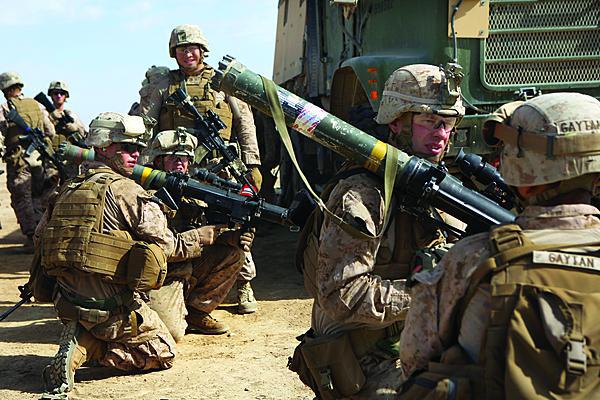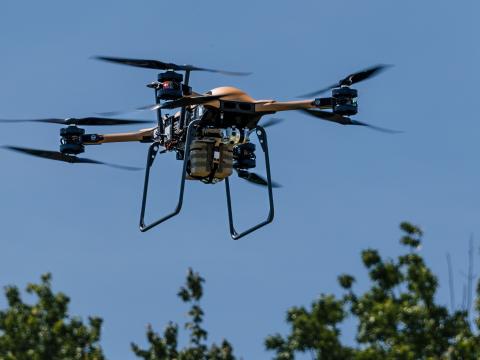The Corps Consolidates Key Capabilities
The U.S. Marine Corps has combined two signals intelligence programs as part of its efforts to drive efficiency and enhance expeditionary operations. Streamlining activities for manpackable and vehicle-borne versions of similar capabilities increases both flexibility and redundancy in the field for the users.
Personnel from the Marine Corps Systems Command’s (MARCORSYSCOM’s) Signals Intelligence Electronic Warfare Integrated Product Team and the Marine Corps Combat Development Command’s (MCCDC) Capability Development and Integration Directorate joined forces on the effort. They created the Tactical Signals Intelligence (SIGINT) Collection System (TSCS) out of the Radio Reconnaissance Equipment Program (RREP) and the Team Portable Collection System (TPCS). Now, the two systems are in a single funding line and will share more components, giving users in the field additional flexibility and interoperability between the two versions. Both systems offer similar functions, such as intercept, direction finding, reporting and collection management to provide Marine Corps Air-Ground Task Force commanders with SIGINT, but they have some different uses and appearances. The TSCS simplifies operations for the user in complex operating environments. When the Marines must respond immediately to a crisis, familiarity and ease-of-use will improve battlefield operations. Marines believe this system moves them in that direction.
Operational Marines will feel the impact of the changes. “We prep the battlespace with intelligence,” Chief Warrant Officer 5 Sailor Hasting, USMC, says, adding that commanders make good, sound decisions only with the proper information. “That, in essence, is why this is important,” he adds. Chief Warrant Officer Hasting is a subject matter expert at MARCORSYSCOM.
Little in the technology itself will change. Rather, the main differences come in the form of logistics, research and development, funding and other administrative facets. The development command looks at requirements and influences developers’ efforts toward the capabilities and program refinements that meet operational needs and gaps. Some of the technological changes include smaller form factors and more modular capabilities. Products will be more software defined than in the past, though operators and analysts will essentially experience the same functionality. Over the course of the next two years, user interfaces will adjust to become simpler. Also, new laptops will be issued. With the enhanced plug-and-play options, Marines will be able to take components from one system and use them in the other if necessary.
The natural offshoot of the work is reduced training time as well as increased familiarity with the equipment units employ. Master Gunnery Sgt. Joseph Starosta, USMC, the SIGINT electronic warfare chief for the Intelligence Integration Division at the MCCDC, explains that the Corps relies on units for training beyond the schoolhouses, so the uniformity of the new system will make that work easier. The footprint of the equipment also will decrease. Such measures are important across the military as service branches face tighter budgets and reduced personnel levels.
The TSCS is an example of the type of move the Marines are trying to make with their Expeditionary Force 21, Master Gunnery Sgt. Starosta says. The concept—scheduled to be released soon—lays out lines of effort important for future operations. Post-Afghanistan, the Corps is focused on returning to its expeditionary roots and projecting power globally. A natural step is to lighten the logistical load of SIGINT operators. “TSCS, along with the other SIGINT electronic warfare programs of record, are going to enable all these other lines of effort for the Marine Corps,” the master gunnery sergeant explains.
Col. Anne Weinberg, USMC, director, Intelligence Integration Division, MCCDC, says all the adjustments toward more streamlined capabilities are tied across operational realms and a range of activities. Marines are consolidating and examining information sharing from the beginning of processes.
The efforts affect not only signals but also other forms of intelligence systems. By understanding capability trade-offs earlier in development, Marines can understand how tools fit their overall needs better. Because the Corps traditionally is a sea service, its materiel must be lightweight, fit onto ships and support expeditionary operations. It also has to function under austere conditions, sometimes with less-than-ideal logistics. During the requirements process, experts need to understand various aspects of a given program. Additionally, they need an understanding of their return on investment to determine the optimal solution within concepts of operations and the reduced fiscal situation.
Over the years of conflict in Iraq and Afghanistan, Marines learned “we live in the world of data,” Col. Weinberg says. That world entails obtaining information and then determining what to do with it. Personnel must tie the data across various intelligence fields and provide it to operators to create more complete pictures of situations. The colonel stresses that industry partners must keep all this in mind when developing solutions because the military no longer can afford stovepiped systems.
Because SIGINT technology follows commercial technology and its rapid rate of advancement, the Marines rely heavily on the private sector, which can adapt more quickly than the service’s acquisition community. Mike Stanford, the SIGINT electronic warfare team lead at MARCORSYSCOM, says he would like industry “to continue the way we’ve been for the last 10 years,” such as being out in front in developing technology.
He also explains how the intra-Corps network of cooperation inherent in the TSCS program combines support teams from the previous two systems to merge the common goals and requirements in an effort to provide operating forces with common solutions. With similar hardware and software, troops can switch more easily from one type of equipment to the other, and because they must only maintain one set of equipment, testing needs decrease, lowering costs. “This is better buying power in action,” Stanford states. The TSCS gives radio battalions more flexibility in the equipment they carry. “It makes it so they’re able to shift their people back and forth across various teams so they don’t have to retrain them,” he says. “That’s a big benefit for them.”
Advances in technology make the TSCS possible. Previously, a manpackable system would be a different equipment set than that necessary for a vehicle. Chief Warrant Officer Hasting explains that because systems are now smaller, reducing differences among them makes equipment sharing simpler. For example, switching personnel from reconnaissance to signal support was difficult before, but common equipment set and training overcomes many of the issues. “I can, as a leader of Marines, plug and play a Marine on anything,” the chief warrant officer says.
Reducing the amount of necessary training does more than save time and money; it allows skills to remain fresh. When troops train on a slew of equipment, expertise atrophies when not employed. The commonalities in equipment increase training efficiency by offering more uniform skill sets. Such efforts extend to both hardware and software, he adds.
Master Gunnery Sgt. Starosta says relationships between civilian employees and Marines create the correct balance of expertise necessary to make the right decisions on these types of projects. He adds that most of the service members have used the equipment in the field and realize the importance of the work on the acquisition side.




Comments